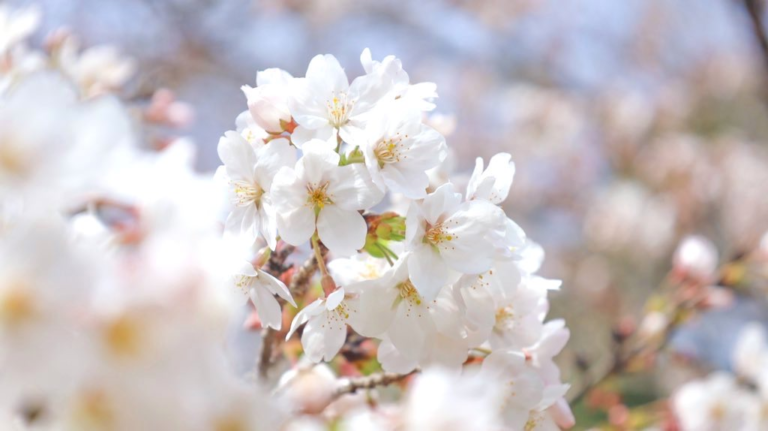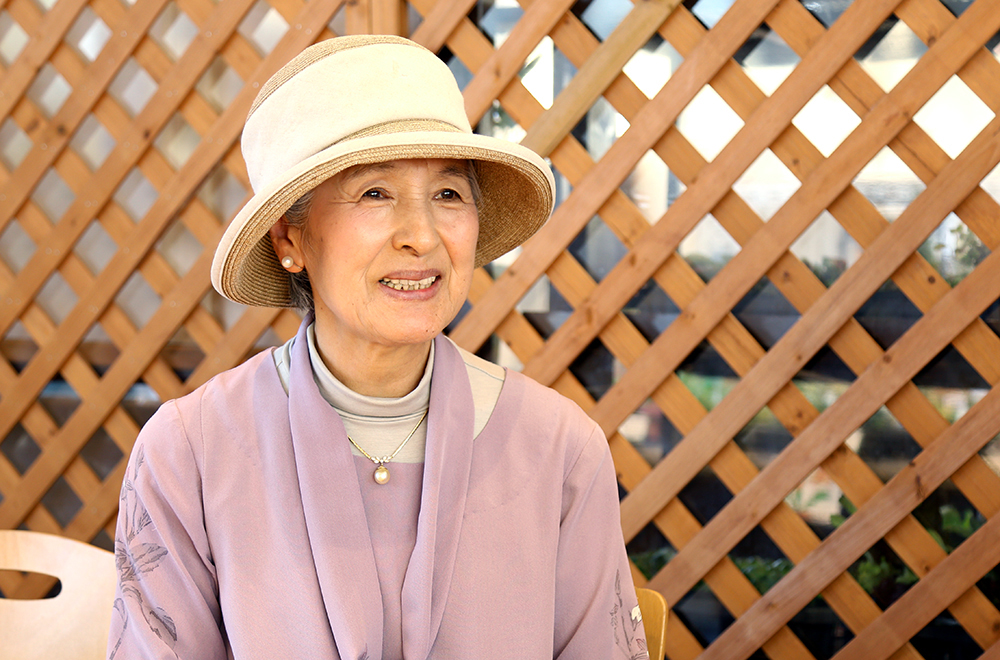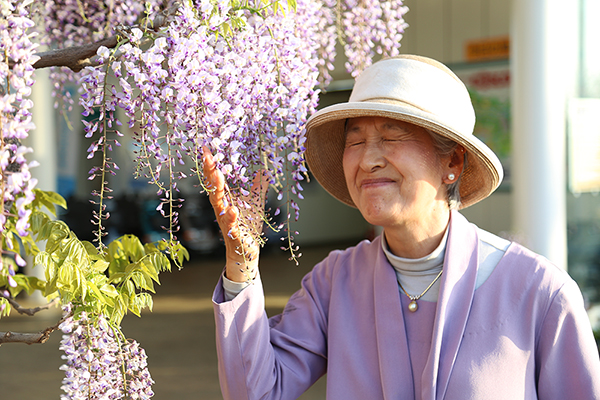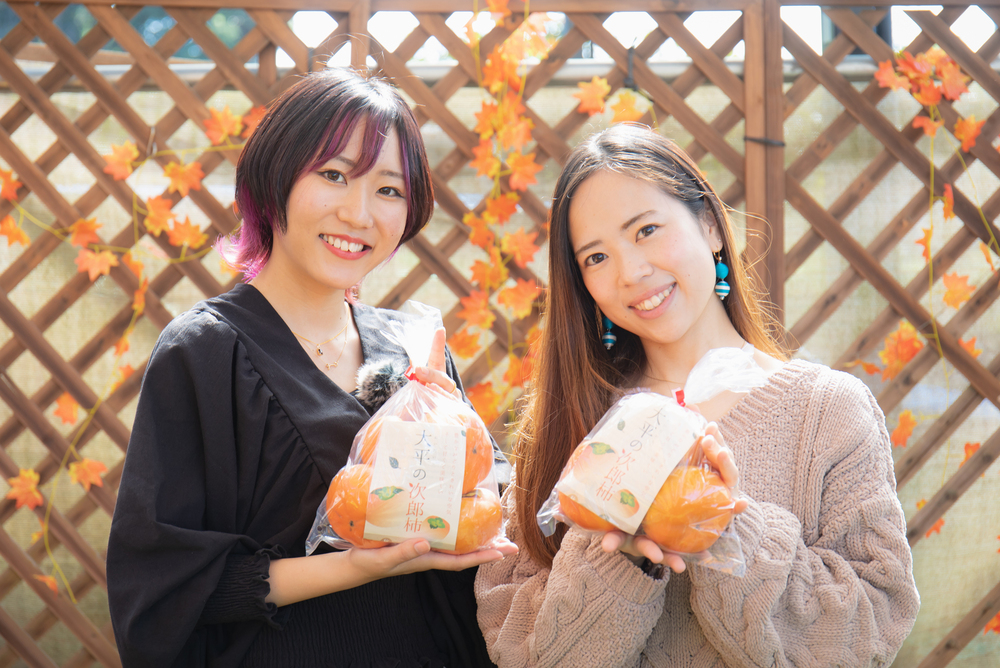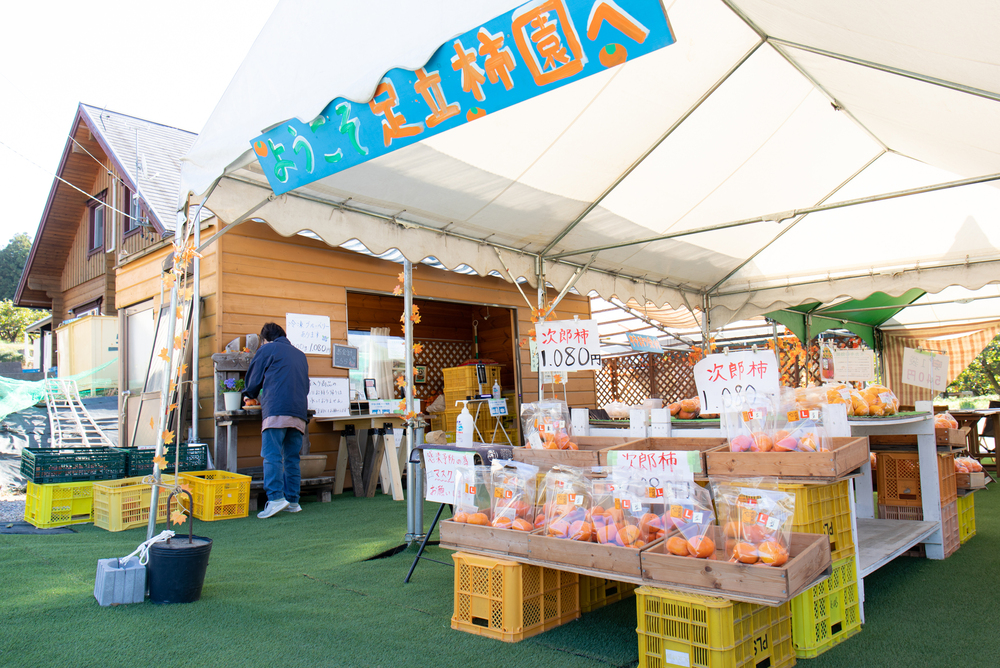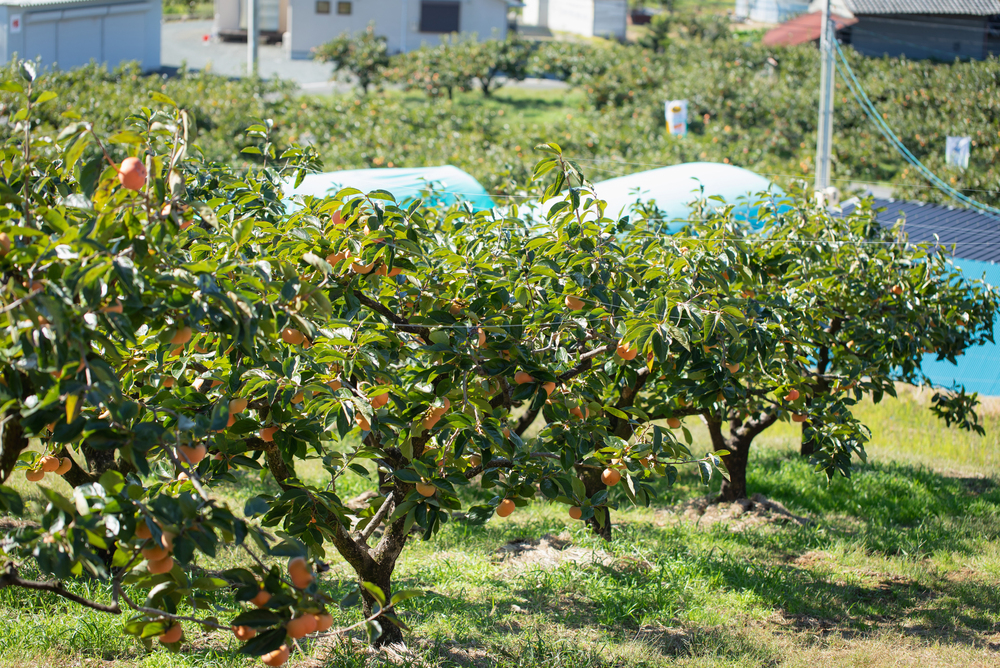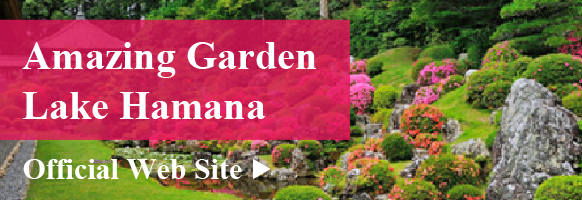Get to Know Hamamatsu
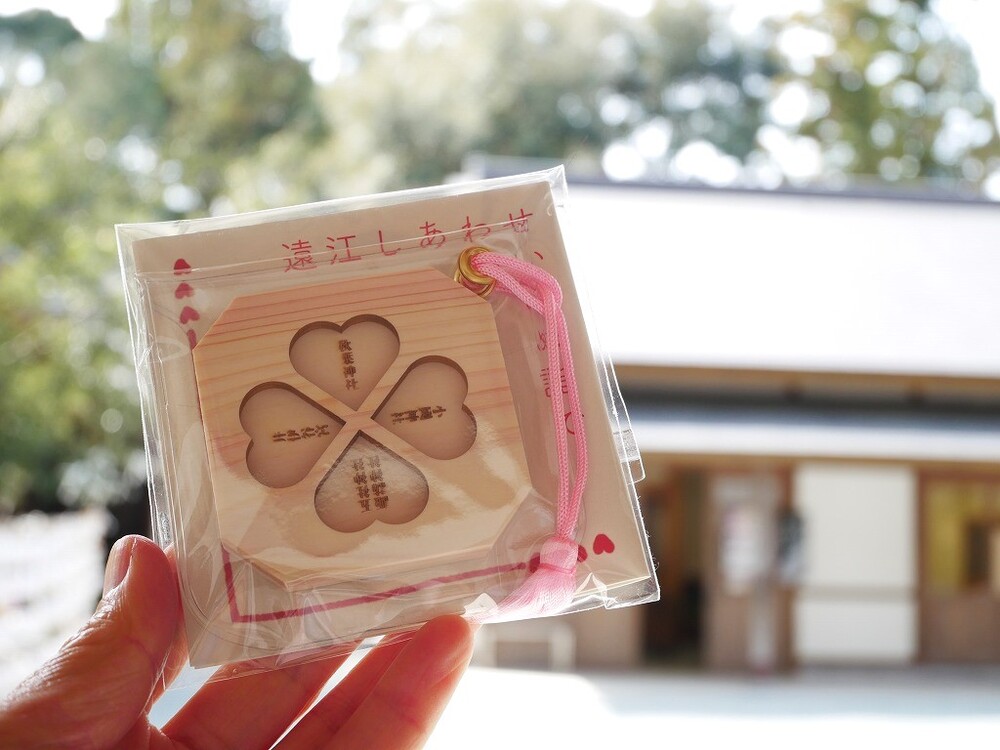
- Enjoy
Good luck by visiting the four shrines! Totomi Happiness: Inome Pilgrimage and Amulet
Do you know “Totomi Happiness and Inome Pilgrimage Amulet”?
This is an initiative to complete an “Inome Pilgrimage Amulet” by visiting four shrines located in the western part of Shizuoka Prefecture (Totomi region) and combining four small “Inome wooden tag amulets” given at each shrine. .
This name comes from the fact that the shape of the wooden tag imitates Inome Inome.
This time, I would like to introduce “Totomi Happiness Inome Pilgrimage Amulet”.
Totomi Happiness What is the amulet for Inome Pilgrimage?
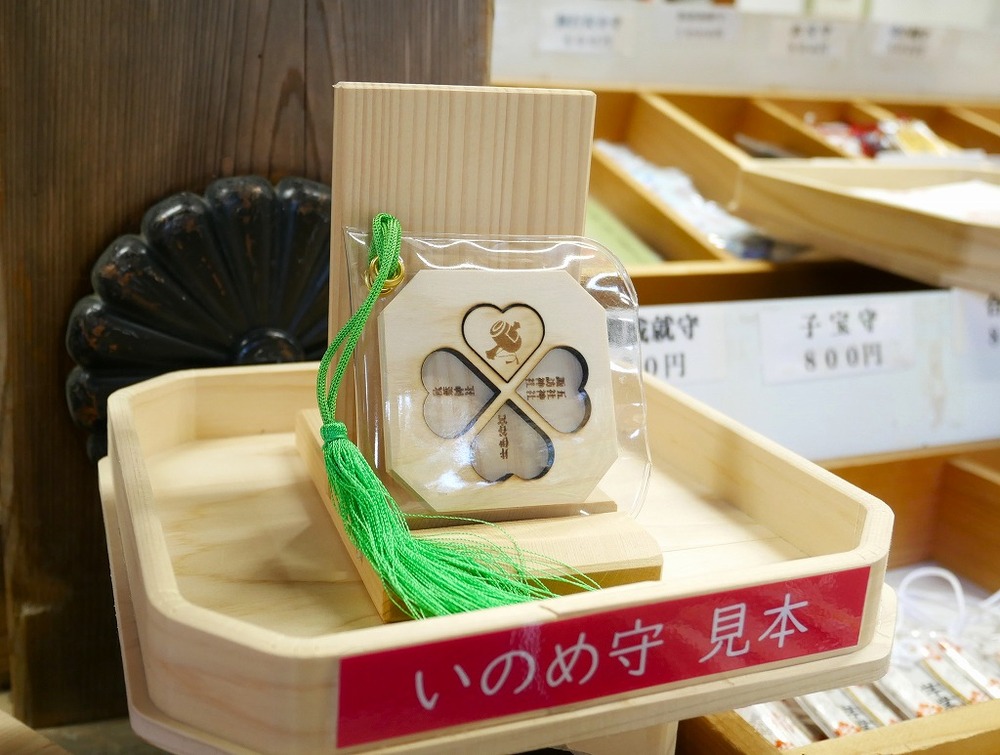
*Oguni Shrine’s Inome Amulet
The “Totomi Happiness Inome Pilgrimage Charm”, which started in late December 2023, involves visiting four shrines located in the north, south, east, west, and east of Shizuoka Prefecture’s western area (Totomi). This is an initiative in which a talisman is completed by fitting it into a special pedestal.
The four shrines, clockwise from the east, are Oguni Shrine in Morimachi, Suwa Shrine, Gosha Shrine in Hamamatsu City, Iiya Shrine, and Akiba Shrine.
There is no particular starting shrine or order for the pilgrimage, so it’s easy to participate.
The motif drawn on the small amulet and the color of the tassels on the cover of the special pedestal vary depending on the shrine.The tassels are green for Oguni Shrine, red for Gosha Shrine and Suwa Shrine, and pink for Iitani Shrine and Akiba Shrine. is yellow.
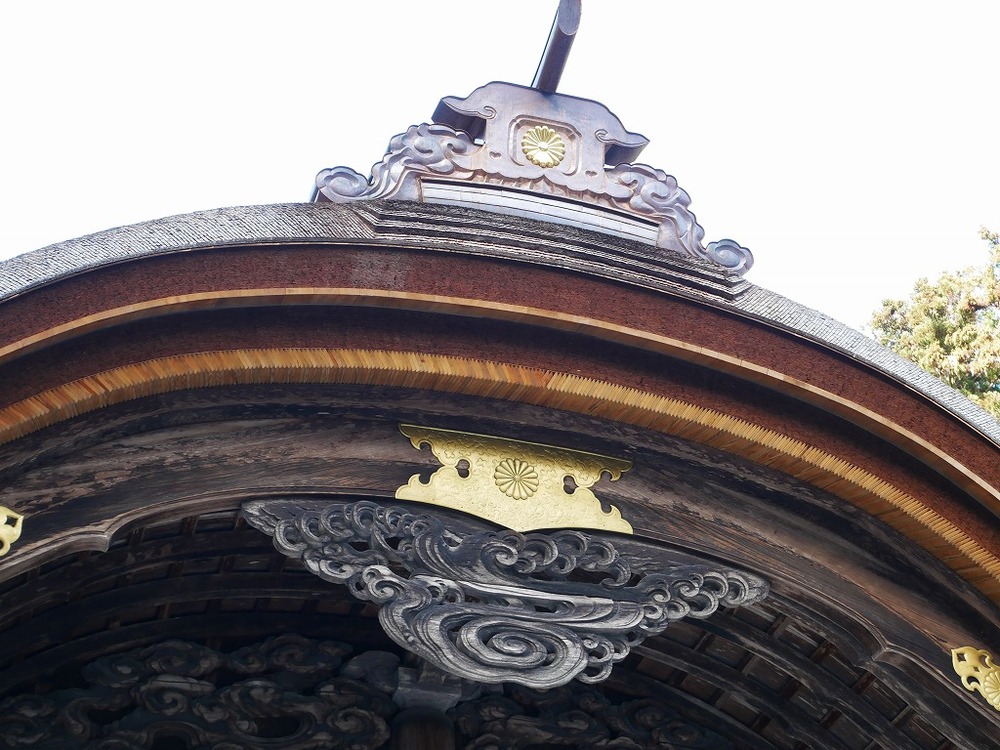
*Inome
At first glance, the shape of the Inome amulet looks like a heart, but this is an imitation of the Inome Inome, a motif that has continued since ancient times to ward off disaster.
It is said that it is still used in more than 80% of shrine buildings today, and at Oguni Shrine, the gable end decoration on the roof of the worship hall is a wisteria kazari, and the karahafu ridge onishikazaki is a fumune onikazari, and the rabbit-haired kakeo unogha. They could be seen on oshigegyo (hanging fish attached to Karahafu).
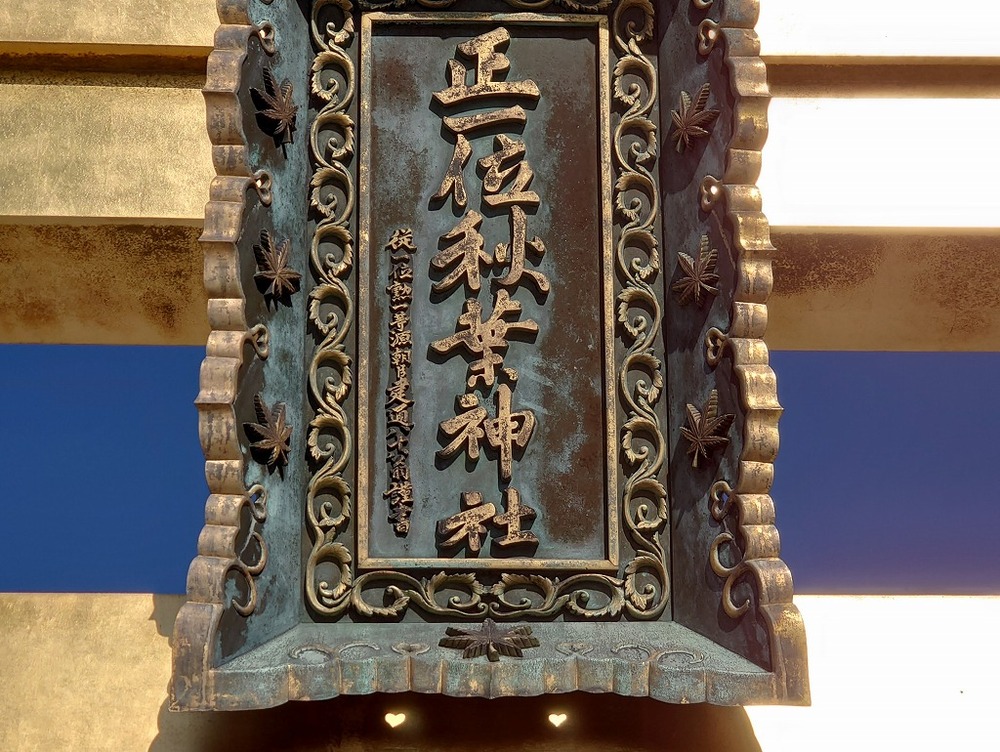
*Inome
At Akihayama Hongu Akiha Shrine, there is an inome on the frame of the torii gate of happiness, and if the conditions are right, you can take a photo like this.
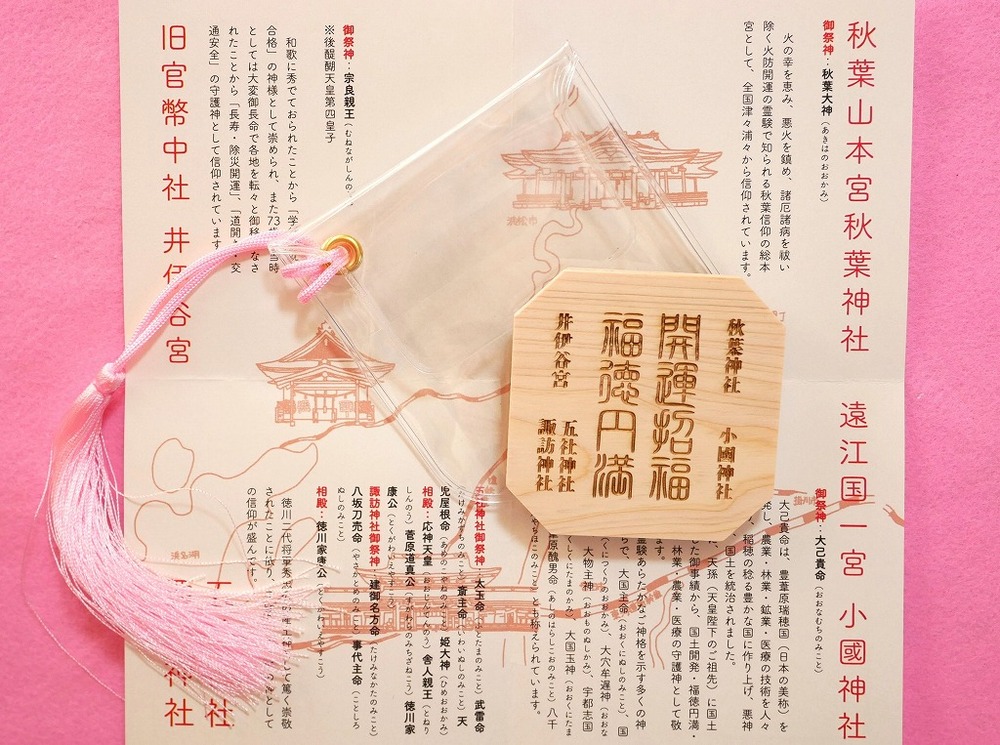
*back side of pedestal
The first fruit fee for the amulet and pedestal is 500 yen each.
It’s about the size of a 50 yen coin, and it’s not heart-shaped…it’s a cute boar-shaped one.
The pedestal on which the Inome Amulet is placed is octagonal, and the back side has the names of the four companies and the words “Good Luck, Blessing, Fukutoku, and Harmony.”
Since you will be visiting four shrines, each of which is enshrined with a different deity and has different benefits, you can expect various good fortunes.
The pink tassel color is cute! Iiyamiya Shrine
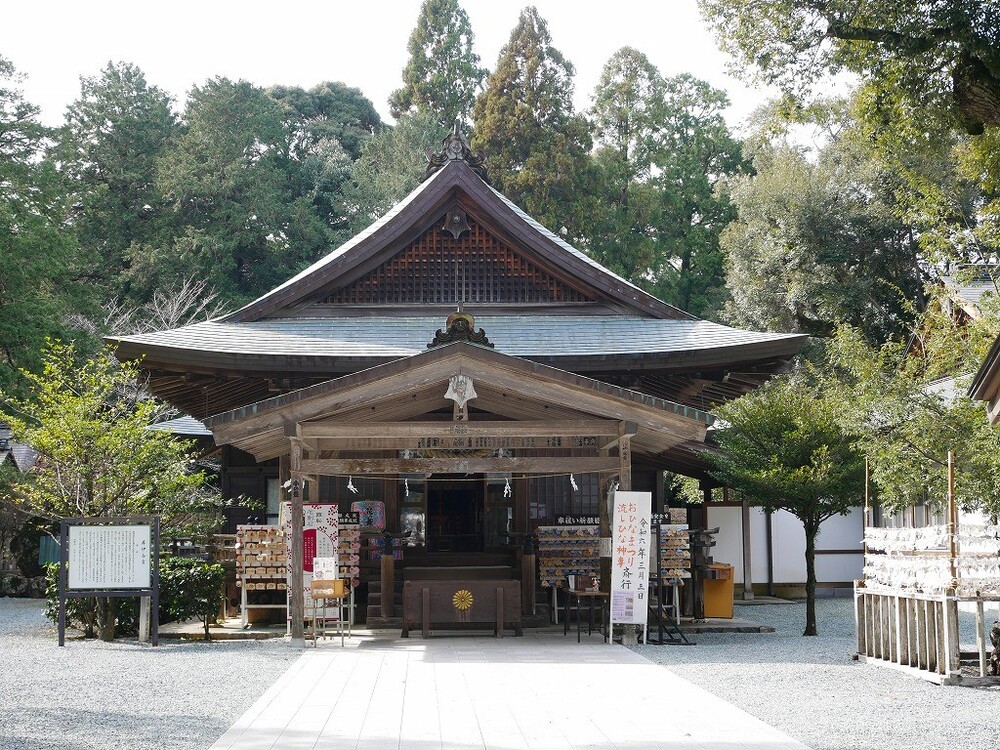
*Iiyamiya Shrine
From here, we will introduce the Inome charms of the four companies.
The order of introduction is counter-clockwise from Iiyanomiya Shrine, as this is where the author was given the pedestal.
The enshrined deity of Iitani-miya Shrine, located on the north side of Ryutan-ji Temple, was built in 1872 (Meiji 5) and was enshrined by Emperor Go-Daigo’s fourth son Munena Munera.
Imperial Prince Muneyoshi passed away here, and his grave is located on the west side of the precincts.
At the time of its founding, Iitanigu Shrine was the second-highest official shrine in Shizuoka Prefecture. It is the birthplace of the Ii family and played a central role in Shinto culture.
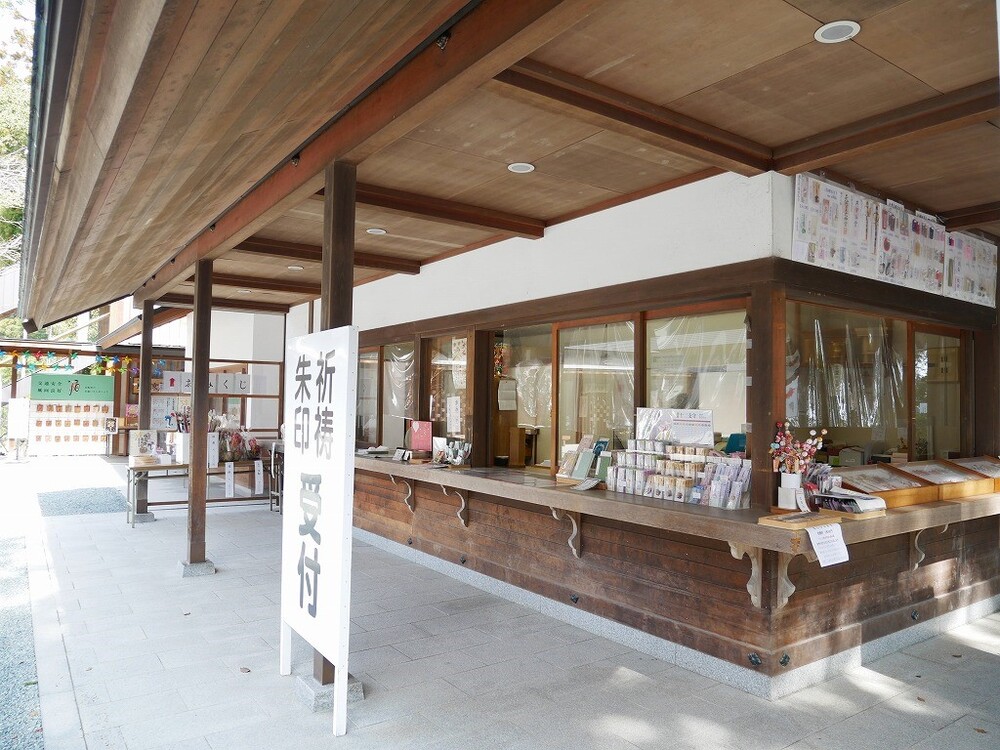
*Iiya Shrine Awarding Place
The Inome Amulet awarding place is on the right after entering from the shrine gate.
The bright red instructions are a landmark.
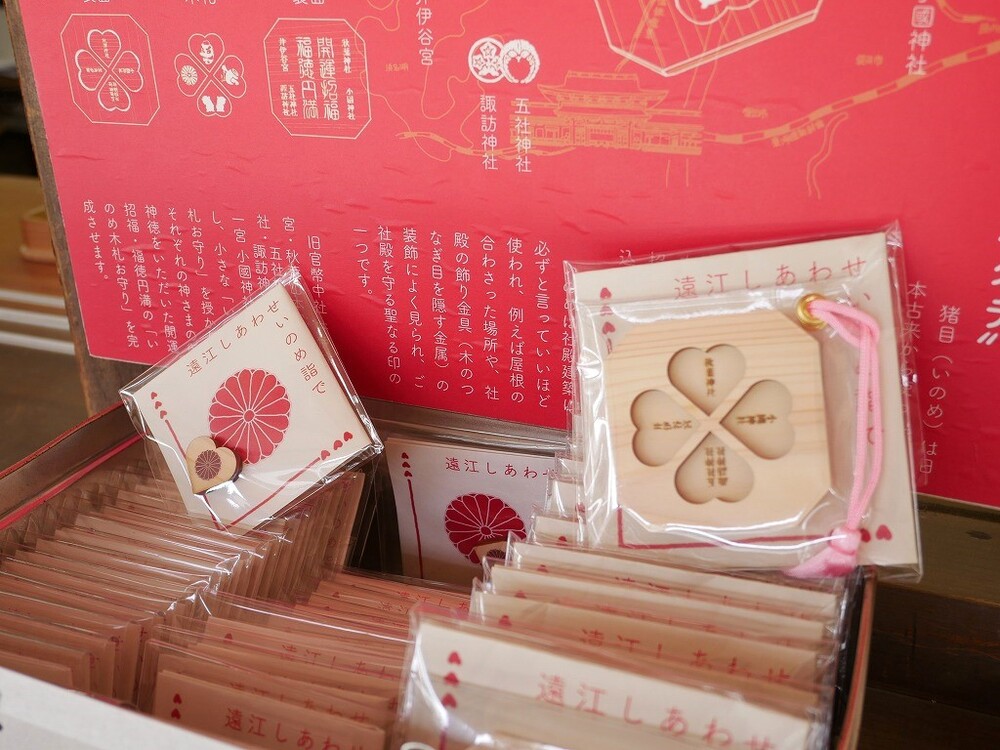
*Inome Amulet of Iiya Shrine
The motif depicted on the amulets of Iiya Shrine is the chrysanthemum crest, as the deity enshrined here is the prince of the Emperor.
The tassel color on the pedestal is pink.
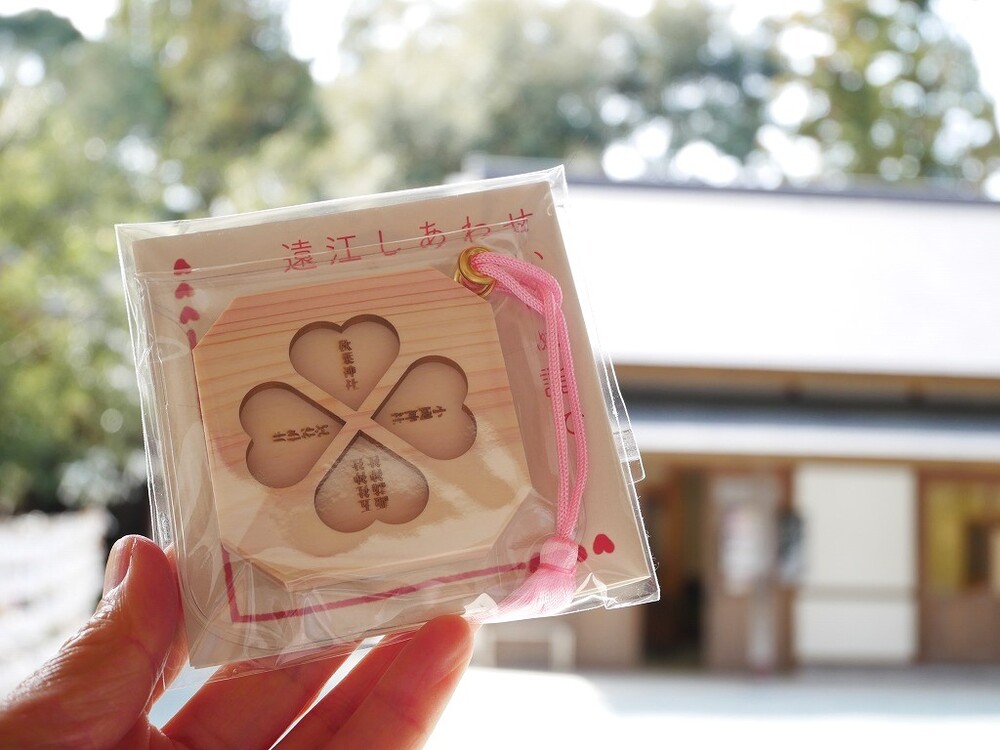
Regarding this tassel color, the tassel color of the pedestal I first got was pink, so I thought that it would be the same color no matter which of the four companies gave me the pedestal.
However, as mentioned earlier, each of the four companies is different.
When I asked Mr. Okabe of Gonne Yigonegi the reason for the colored tassels, he answered, “Because the enshrined deity, Imperial Prince Muneyoshi, liked plum flowers.The title of the collection of waka poems compiled by the Imperial Prince was “Li Kashu.” “Actual plum flowers are whitish in color, but plums and peaches are related,” I received the answer.
The Imperial Prince’s waka poems are displayed at several places along the approach to the shrine, so be sure to look for them before or after your visit.
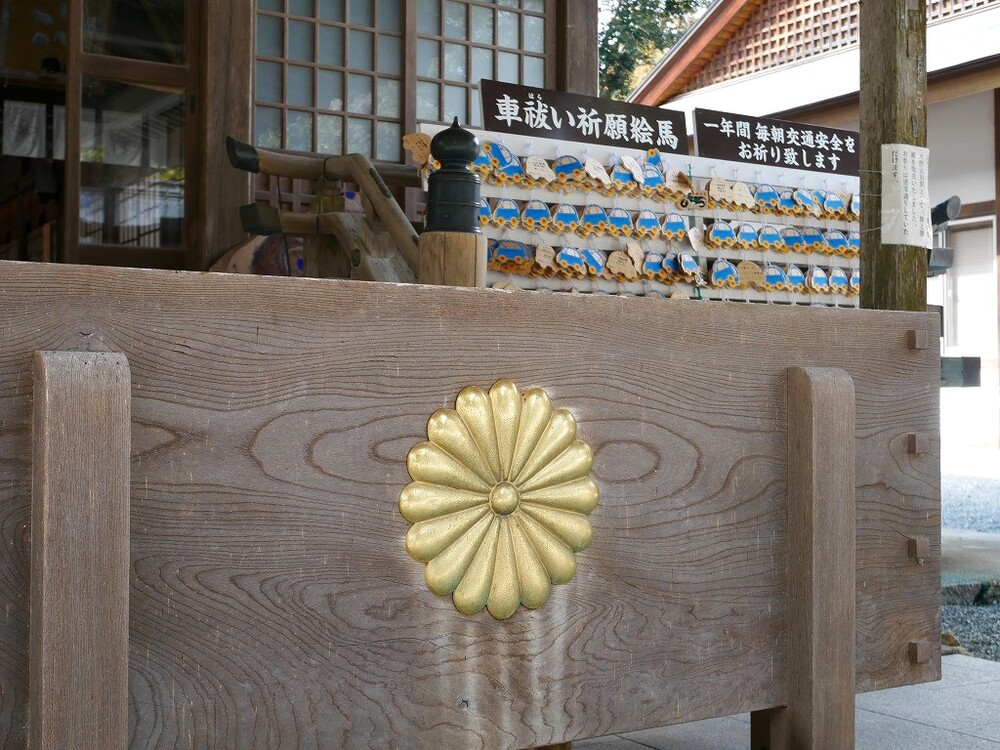
*Motif of Inome Amulet of Iiyan Shrine (Chrysanthemum Crest)
The chrysanthemum emblem can be seen on offering boxes, etc.
*The first fruit fee for the amulet and pedestal is 500 yen each, but Iitanigu Shrine does not award just the pedestal.
However, if you received only the amulet when there was no pedestal, you can receive only the pedestal by showing the amulet.
For more information, please contact Iiyanomiya.
<How to access Iiya Shrine>
Address : 1991-1 Iitani, Inasa-cho, Hamana-ku (formerly Kita-ku), Hamamatsu City
Access : 15km north-northwest from JR Hamamatsu Station
Bus : Take the bus bound for “Okuyama” from Hamamatsu Station Bus Terminal #15, get off at “Jinguji” and walk for about 5 minutes.
Railway : Get off at Tenryu Hamanako Railway “Kanasashi Station” and walk for about 40 minutes
Parking : Available (free, 1st parking lot 30 spaces / 2nd parking lot 50 spaces)
Iiyanomiya official website (external japanese link)
The color of the tassel is the red of the shrine! Gosha Shrine Suwa Shrine
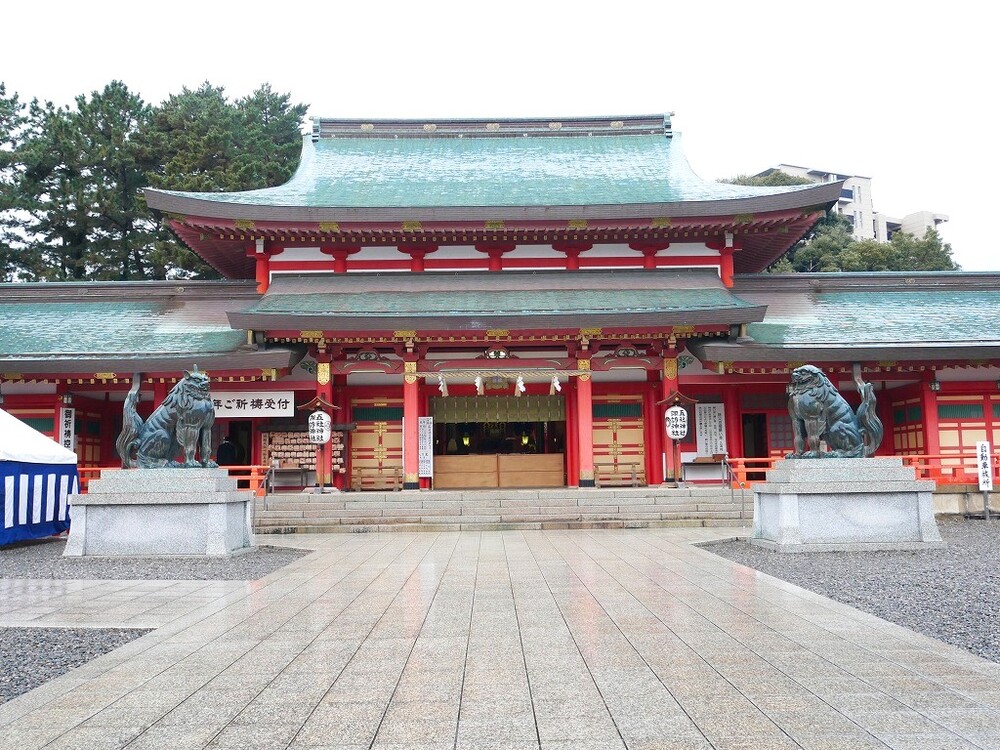
*Gosha Shrine Suwa Shrine
Approximately 1 km west of JR Hamamatsu Station.
The five shrines of Suwa Shrine each have different origins and deities enshrined. This is because they were once separate shrines.
Before moving to its current location, Gosha Shrine was located in Ninomaru of Hamamatsu Castle, and Suwa Shrine was located in Otemae, Hikima Castle (and before that, it was located at Ropponmatsu in Nakajima 1-chome).
Gosha Shrine was moved to this area at the end of the Sengoku period, and Suwa Shrine was moved to this area at the beginning of the Edo period, and both shrines stood side by side until they were enshrined together in the 1960s and became one shrine as it is today.
Both shrines enshrine Ieyasu as a side shrine (a deity enshrined in addition to the main deity).
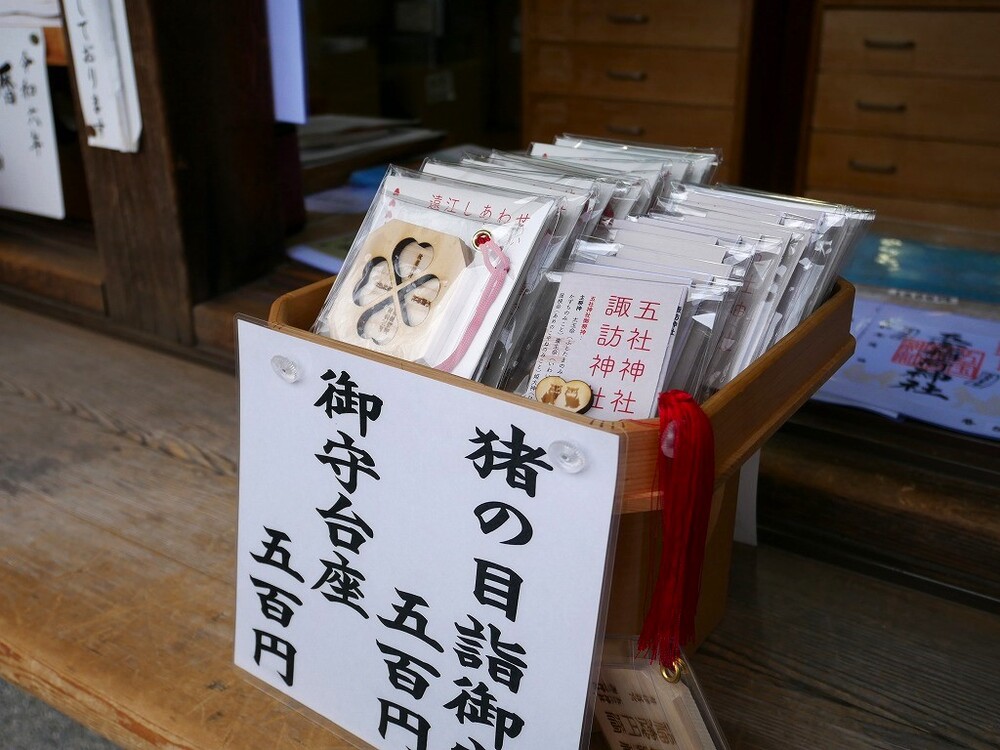
*Gosha Shrine Suwa Shrine awarding place
The Inome Amulet awarding place is on the right after passing through the torii gate.
At the time of my visit, both the pedestal and the amulet were available.
It may be difficult to see due to the reflection of light, but the color of the tassels is red. According to Mr. Suzuki of Gonegi, this is because the shrine building is bright vermilion.
The color of the tassels seems to have been copied directly from the bright color of the shrine building.
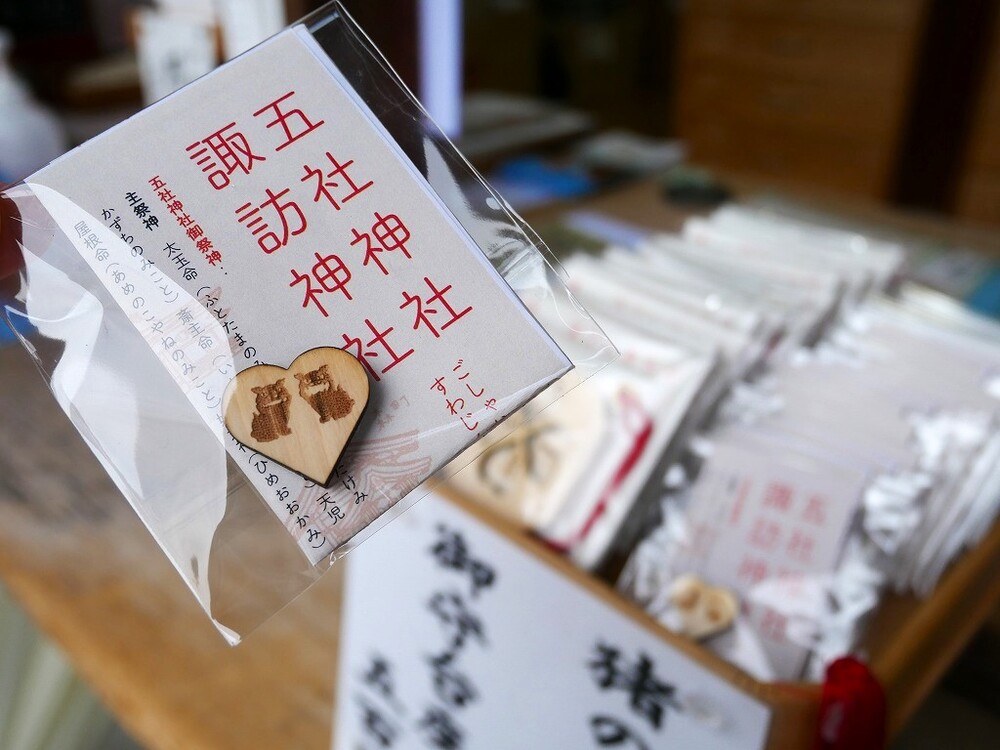
*Gosha Shrine Suwa Shrine Inome Amulet
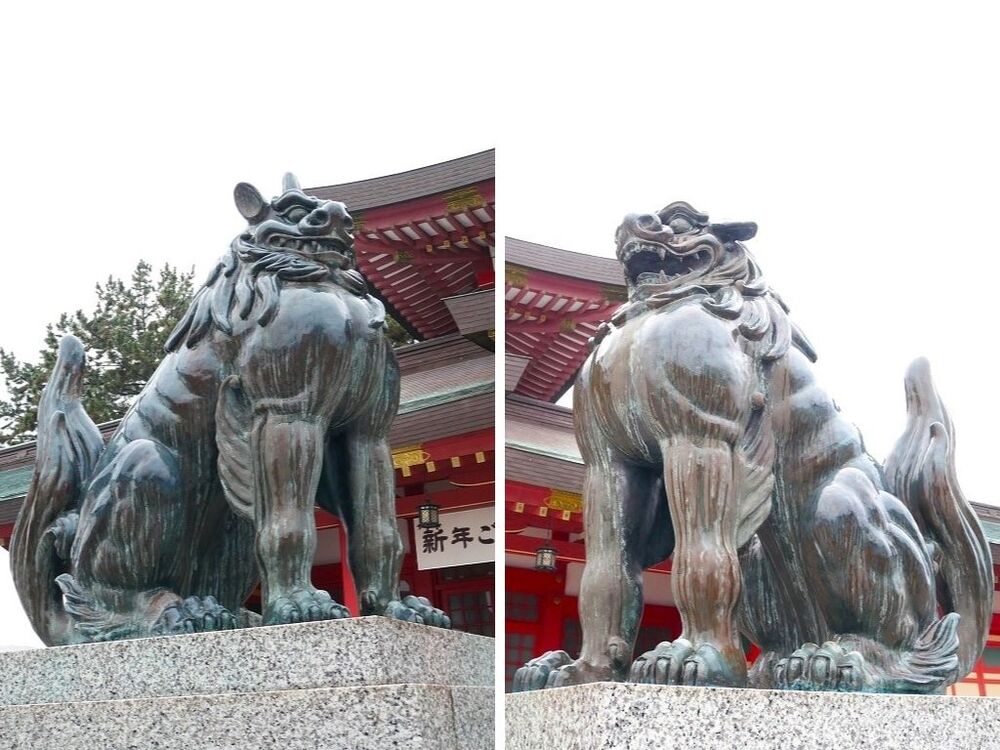
*Motif of the Inome amulet at Gosha Shrine Suwa Shrine (guardian dog in front of the shrine)
The two guardian dogs of the shrine are depicted on the Inome amulet. This motif is based on the guardian dog’s power to ward off evil spirits and misfortune, and to blow away bad things.
Don’t you think that a pair of guardian dogs that fit inside the Inome are so cute?
The guardian dog in front of the shrine is made of bronze and is one of the largest bronze guardian dogs in Japan.
Please look up and take a look before or after your visit.
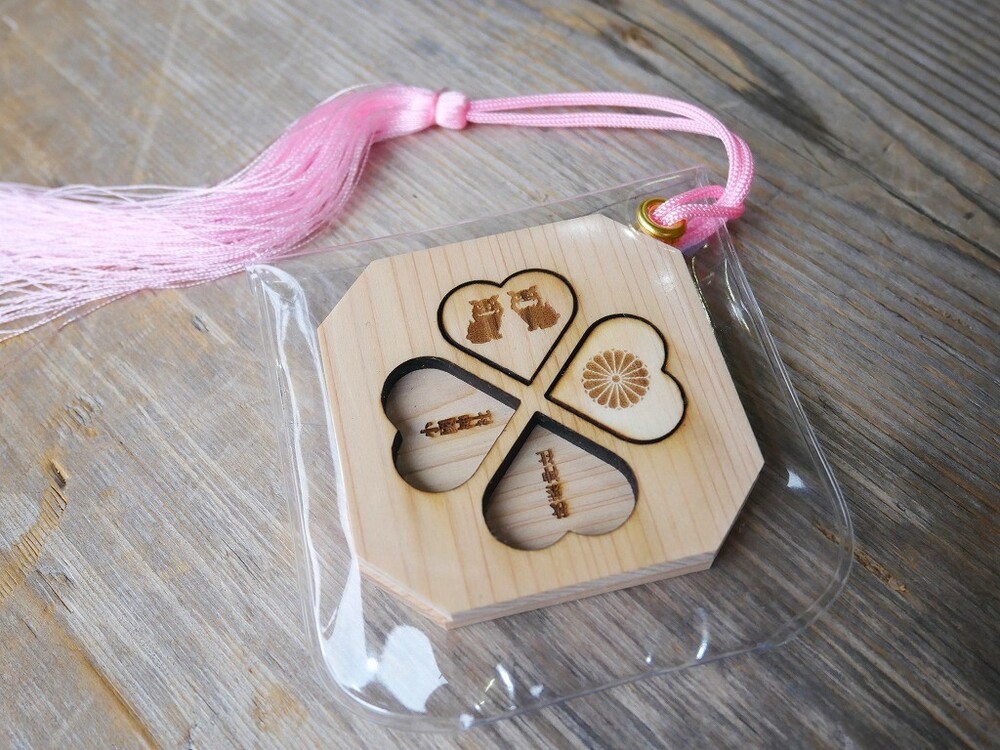
*Inome amulets from Iiya Shrine and Gosha Shrine Suwa Shrine are fitted
After visiting Gosha Shrine and Suwa Shrine, my Inome Amulet has two motifs.
In addition, the material of the pedestal and wooden amulet is Tenryu Cedar! …It’s not Kiso Hinoki.
<How to access Gosha Shrine Suwa Shrine>
Address : 302-5 Torimachi, Chuo Ward, Hamamatsu City (formerly Naka Ward)
Access : Approximately 1 km west of JR Hamamatsu Station (next to the Educational and Cultural Center)
Walk : Approximately 10 minutes from JR Hamamatsu Station
Bus : From Entetsu Bus Terminal in front of Hamamatsu Station
・Sanarudai Danchi Medical Center Ohiradai bound, get off at “Education and Bunka Kaikan” and go about 200 meters to the west
・Yamanote Red Bean Mochi Medical University Seirei Izumi Takaoka Himekaido Garage Seireimawari – Get off at “Tenmacho” and go west about 200 meters
・City Hall Municipal Ground Asahigaoka/Miyakoda City Hall Aritama Minami Medical University Mikkabi After getting off at “Tenmacho”, go west about 200 meters
Parking : Available (free, capacity for approximately 80 cars)
Official website of Gosha Shrine Suwa Shrine (external japanese link)
The green of the bunches is blue maple! Oguni Shrine
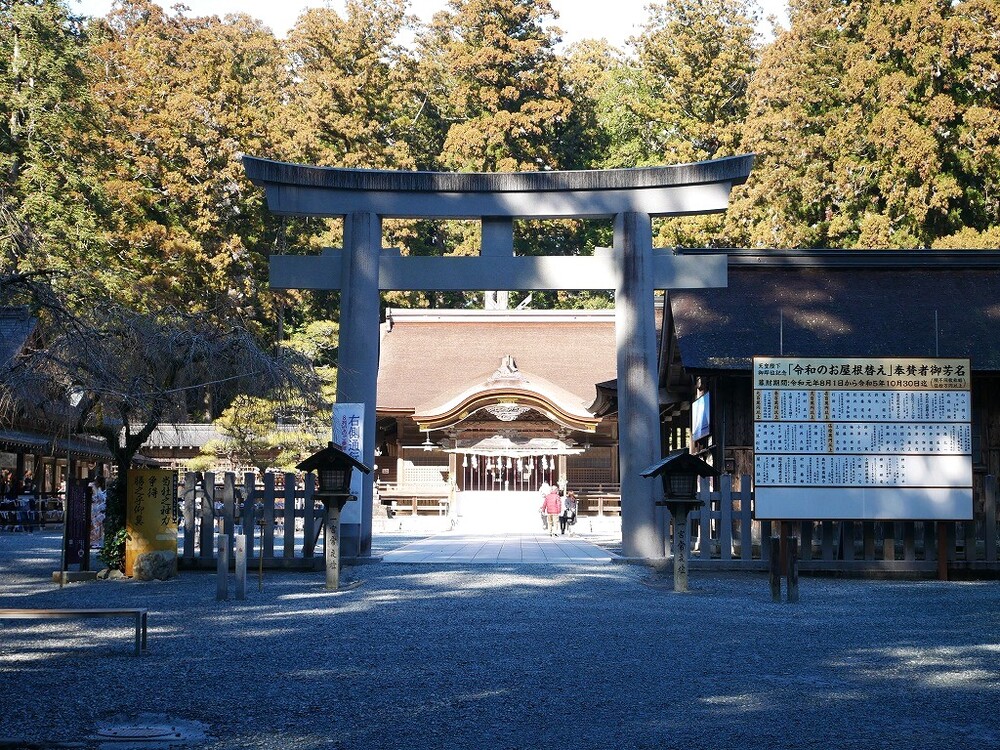
*Oguni Shrine
Approximately 22 kilometers northeast of JR Hamamatsu Station.
The deity enshrined at Oguni Okuni Shrine, which is surrounded by deep green nature, is Oonamuchi no Mikoto.
He is also known as Daikoku-sama, and is popular as the god who saved the white rabbit in the Japanese mythology, “The White Rabbit of Inaba Inaba.”
As you walk along the long approach, the worship hall will appear in front of you.
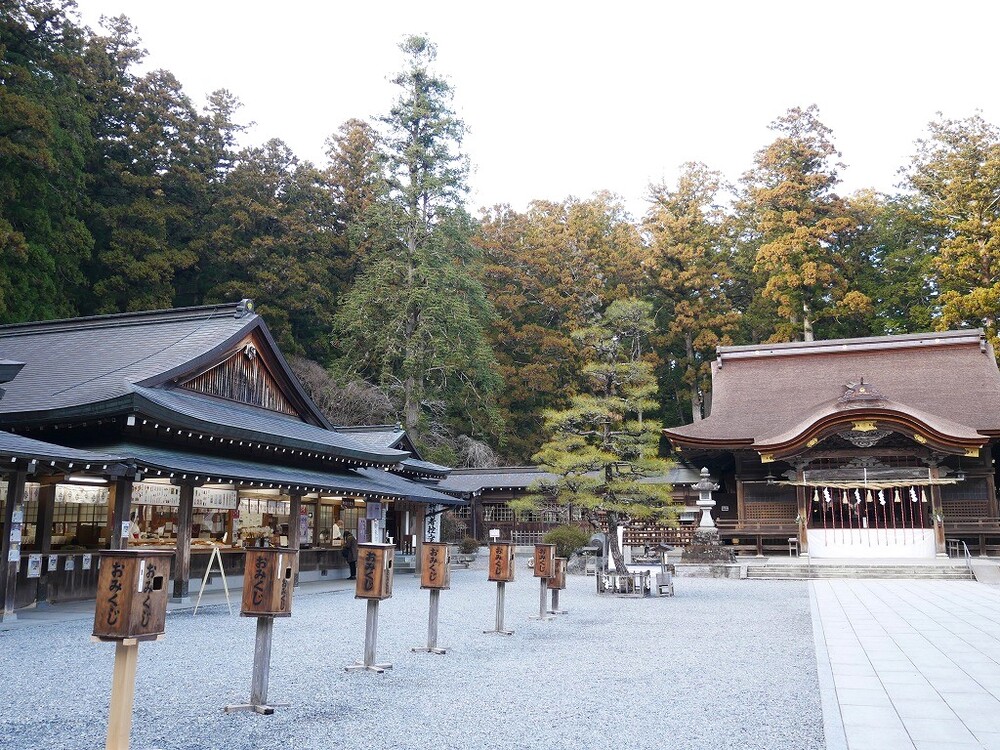
*Oguni Shrine awarding place
The place for awarding goshuin stamps, etc. is a large and calm building with a torii gate and a talisman.
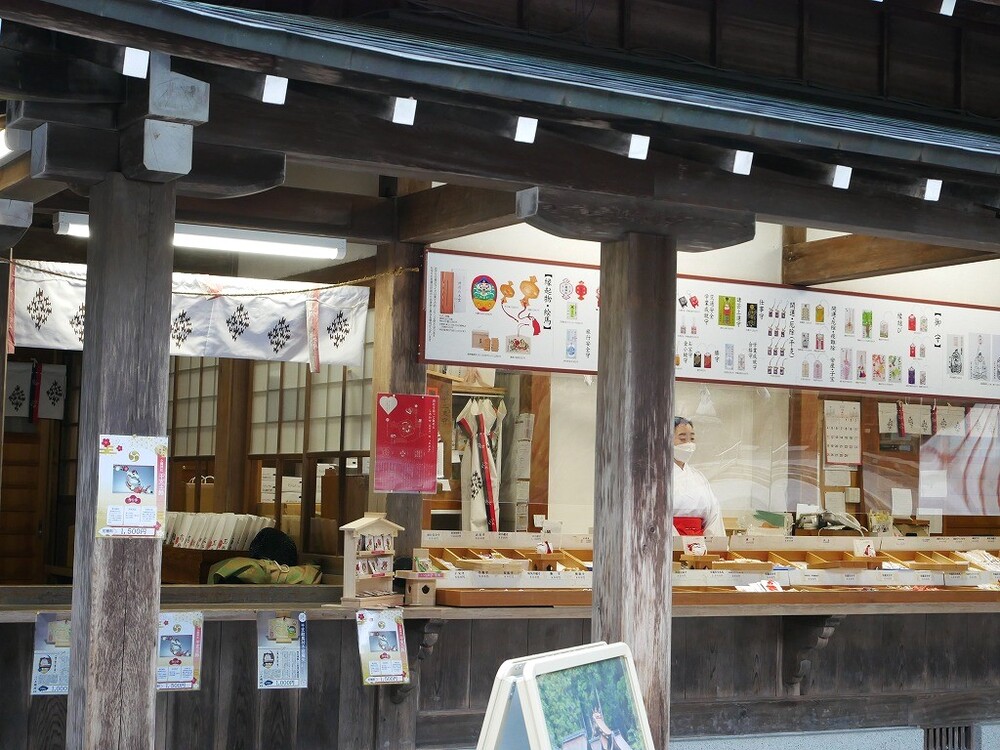
Inome amulets are placed on the left side of votive tablets, amulets, etc.
The bright red explanatory notes posted on the pillars are eye-catching even in a large awarding hall.
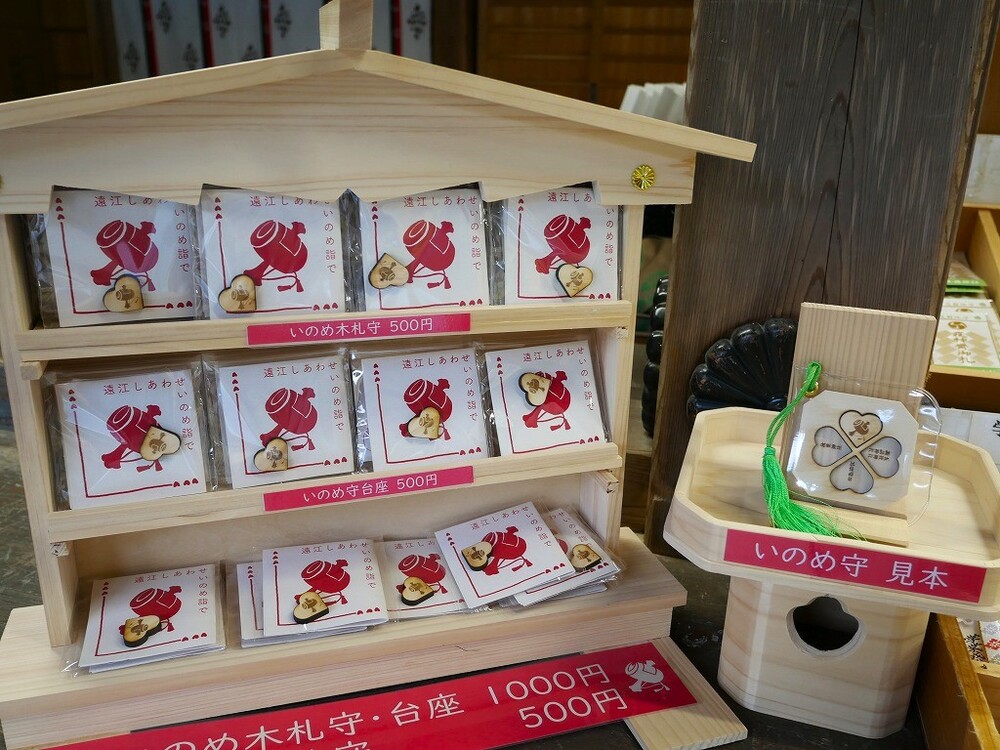
*Oguni Shrine’s Inome Amulet
As you can see, the Inome Amulet from Oguni Shrine was housed in a wooden display shelf. This is an original display shelf made by a Shinto priest at the company using a talisman holder.
Just looking at the rows of hammers with motifs drawn on the Inome Amulet will make you happy.
There are samples of the pedestal on three sides next to the amulet. As you can see, the bunch color is green.
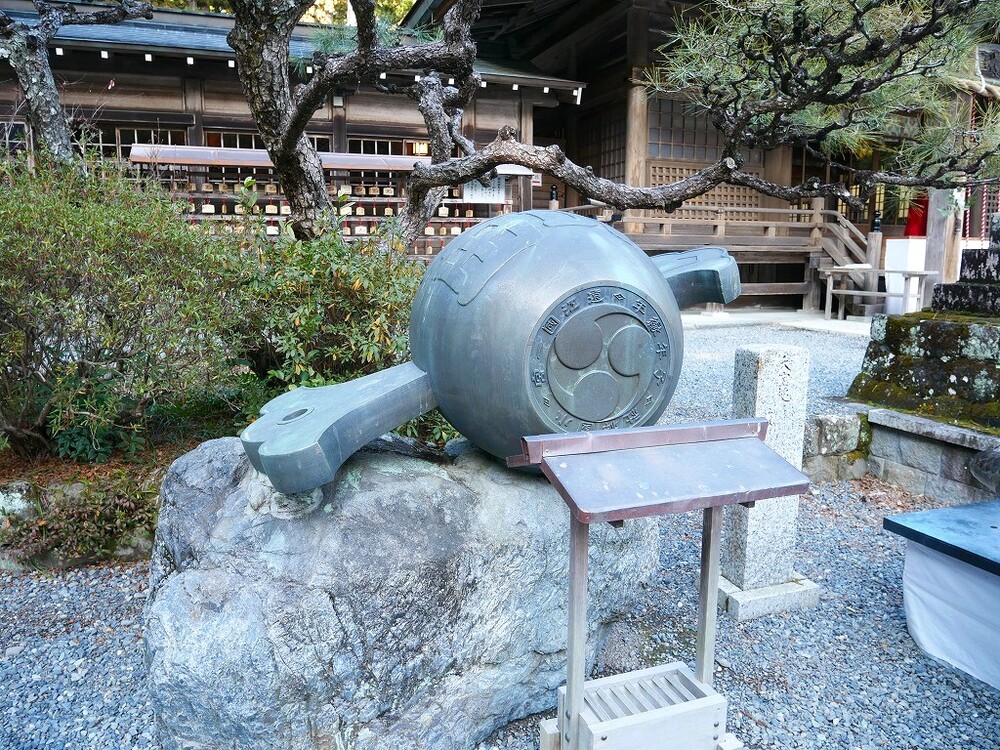
*Motif of the Inome charm at Oguni Shrine (the hammer in front of the shrine)
The reason why the motif of the company’s amulet is a hammer is because it is held in the hand of the enshrined deity, Okami no Mikoto.
“Each of the four shrines enshrines a different god, so please receive the divine virtues of the four shrines by visiting the shrines,” says Mr. Uchida of Negi.
By visiting the four shrines, you can expect various benefits.
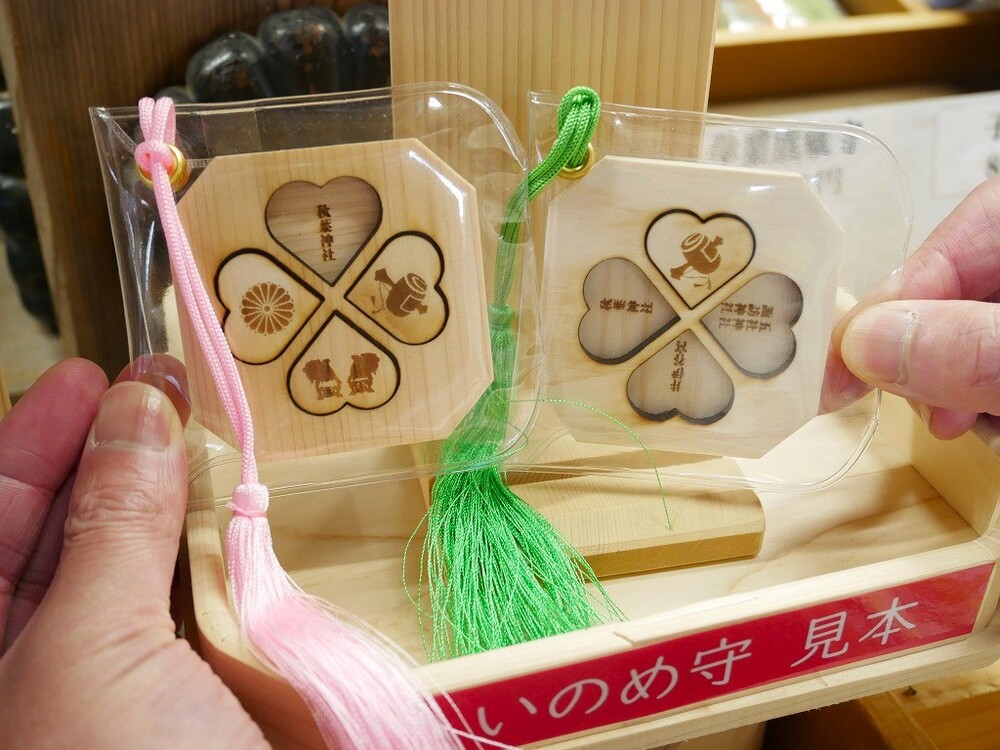
*Left: Author’s Inome Amulet, Right: Oguni Shrine’s Inome Amulet
After visiting Oguni Shrine, I now have three motifs in my Inome Amulet.
oh yeah.
The green color of the clusters on the pedestal seems to come from the color of the blue maple leaves that decorate the grounds.
Oguni Shrine is known as a famous spot for autumn leaves, but the blue maple leaves from spring to early summer are also beautiful.
From April to May, and before the rainy season begins in June, the leaves become more vibrant day by day, changing from fresh green to deep green.
Please take a look during your pilgrimage.
<How to access Oguni Shrine>
Address : 3956-1 Ichinomiya, Morimachi, Shuchi-gun, Shizuoka Prefecture
Access : Get off at Ichinomiya Station on the Tenryu Hamanako Railway, then walk for about 50 minutes (about 3.6 km)
Parking : Available (free, accommodates approximately 900 cars/dedicated parking lot for large buses)
Oguni Shrine official website (external japanese link)
The color of the tassel is the torii gate of happiness! Akihabara Hongu Akiba Shrine
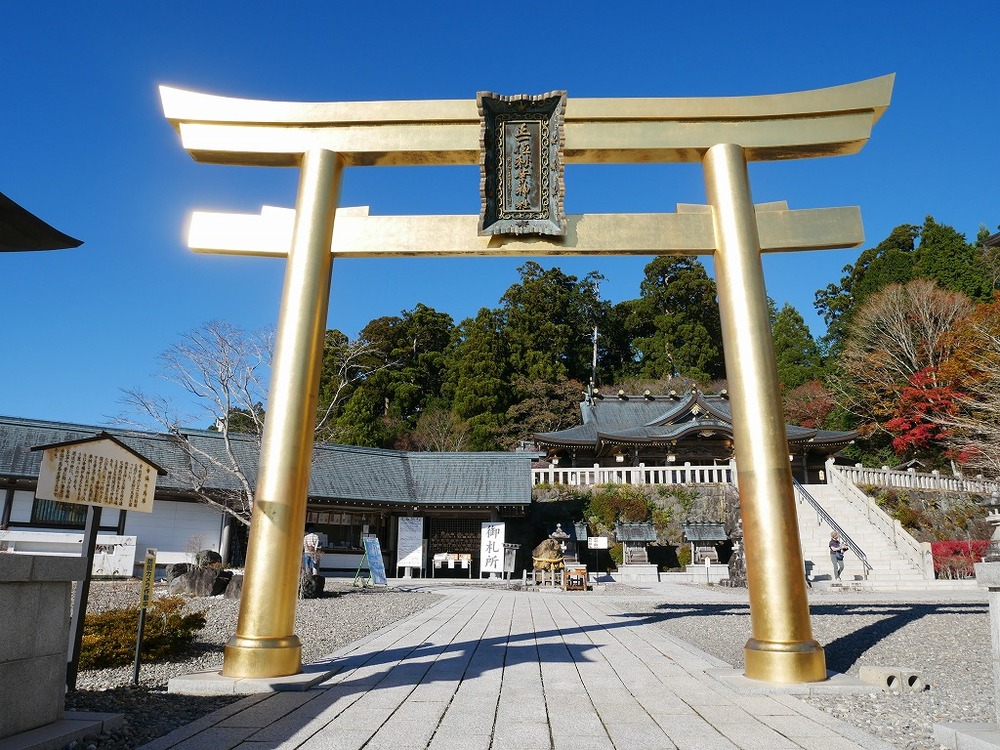
*Akihayama Hongu Akiha Shrine “Torii of Happiness”
Approximately 33 kilometers north-northeast from JR Hamamatsu Station.
Akiba Shrine is located on the summit of Mt. Akiba at an altitude of 866 meters overlooking the Totomi region, and has an upper shrine at the summit of Mt. Akiba and a lower shrine where the main shrine on the mountain can be worshiped from a distance at the foot of the mountain.
The enshrined deity is the presiding deity of fire, Hinokagudo Okami, who is known as the god of fire protection, and the Akiba Fire Festival (Fire Prevention Festival) is held every December.
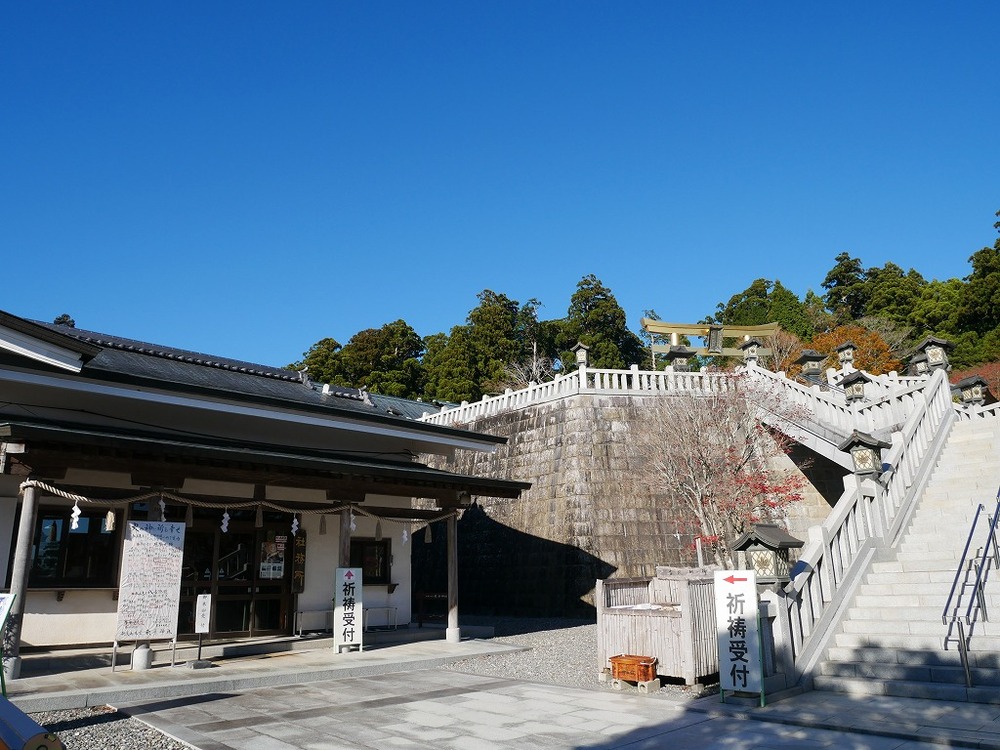
*Akiba Shrine Award Office (Shrine Office)
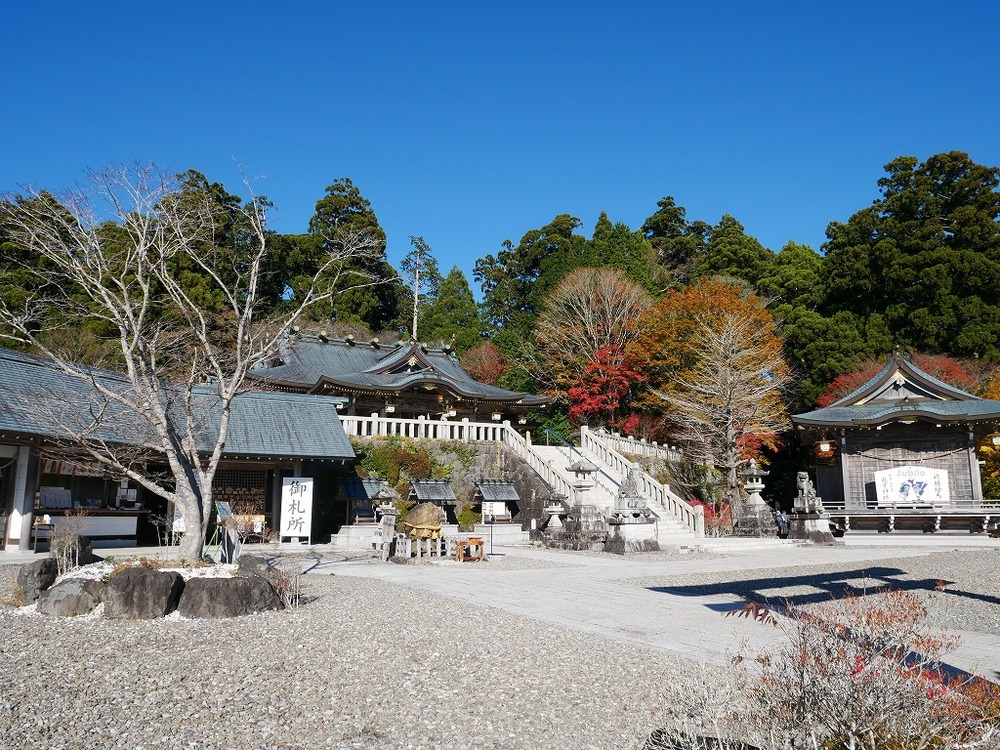
*Akiba Shrine awarding place (amulet place)
Some people may wonder, “Can I receive an Inome Amulet at a shrine at the foot of a mountain?”
There are a total of five places in Kamisha and Shimosha where you can receive amulets and cursed bows, but Kamisha is the only place where you can receive Inome Amulet.
There are three awarding places in Kamisha: the shrine office, the one across from the shrine office, and the amulet on the left after passing through the Torii of Happiness.
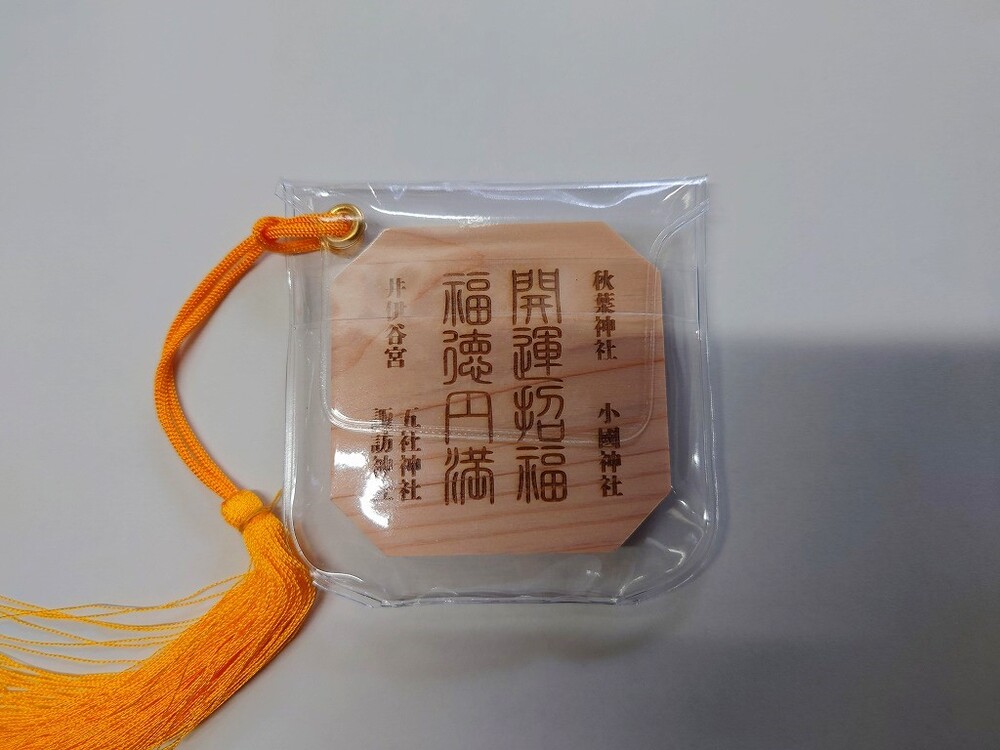
*Akiba Shrine’s Inome Amulet
The motifs depicted on the amulets at Akiba Shrine are the Tengu, the divine messengers and servants of the deity enshrined at Akiba Shrine.
When I asked Mr. Kawamura, the chief priest, the reason for this, he answered, “I chose this tengu so that I could receive blessings from God through it.”
“The color of the tassels on the pedestal was orange-yellow, in reference to the golden torii gate of happiness.”
Every time I look at the pedestal I received at Akiba Shrine, I think of the torii gate of happiness.
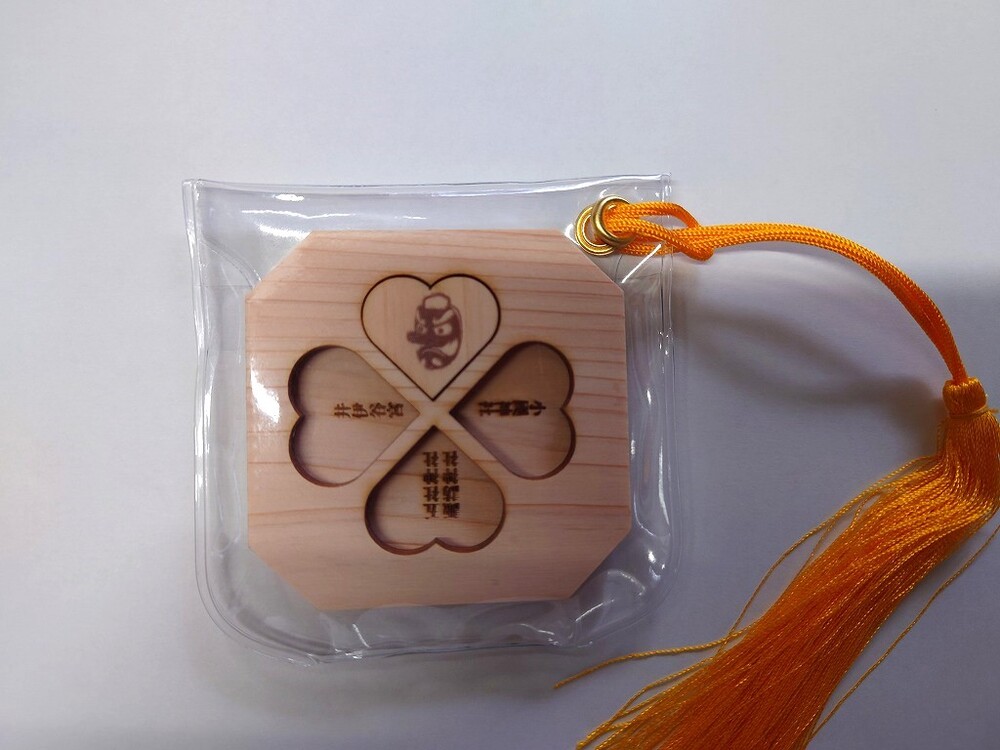
*Akiba Shrine’s Inome Amulet Motif (Tengu)
The tengu that is the motif of the amulet can be seen all over the shrine grounds, so why not look for them?
<How to access Akiba Shrine Kamisha>
Address : 841 Ryoke, Haruno-cho, Tenryu-ku, Hamamatsu City
Access : Approximately 70 minutes from the Tomei Expressway “Hamamatsu” IC / Approximately 40 minutes from the Shin-Tomei Expressway “Hamamatsu Hamakita” IC
*Public transportation: Usually, on Sundays from November to mid-December, during the fire festival period, and during the New Year’s visit peak season in early January, there is a special direct bus service from the Enshu Railway Nishikashima Ekimae bus stop.
Parking : Available (free, accommodates over 300 regular cars and 20 large buses)
Akiba Shrine official website (external japamese link)
Visit four companies and match the four motifs to create Shiawase(happiness)!
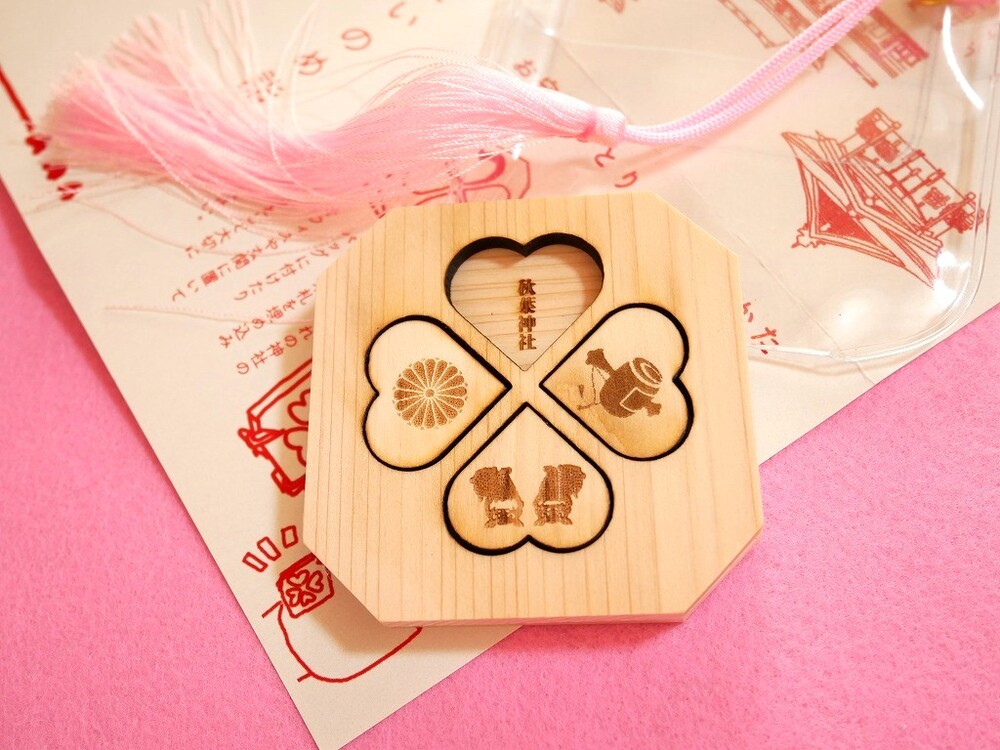
*Inome amulet with motifs of Iiya Shrine, Gosha Shrine Suwa Shrine, and Oguni Shrine
The motifs of the Inome amulets are a chrysanthemum crest, a guardian dog, a small hammer, and a tengu, each of the four shrines.
Each shrine has its own unique characteristics.
By the way, these four shrines are located in the north, south, east, and west of the Totomi region, but what is their relationship with the four guardian deities that protect the four directions of the heavens (Seiryu, Byakko, Suzaku, and Genbu)?
So I asked Mr. Goneyoshi Suzuki of Gosha Shrine Suwa Shrine, and he answered, “There is no particular connection to the four gods, and the four shrines are the representative shrines of the Totomi region, so they are scattered in all directions.” I received it.
It makes sense that the colors of the tassels do not correspond to the four gods.
*Color compatible with the four gods…East (Blue/Seiryu), West (White/Byakko), South (Vermilion/Suzaku), North (Black/Genbu)
During the Meiji period, the four shrines that started this initiative had schools for Shinto priests as representatives of their respective regions, and became the base of Shinto culture in the Totomi region.
Today, 150 years have passed since that connection, and we still maintain exchanges by participating in annual festivals.
And this time, the four shrines have once again joined hands to begin the “Totomi Happiness Pilgrimage and Amulet,” which is completed through a pilgrimage.
By visiting the four shrines that pray for the peace of the Totomi region, you can calm your mind and refresh your mind.
May happiness come to everyone who makes the pilgrimage.
